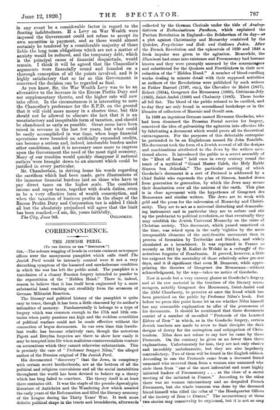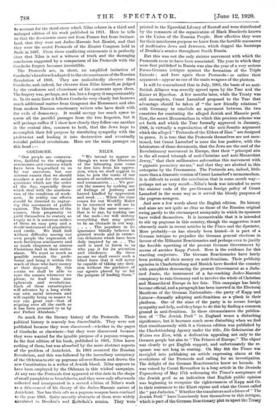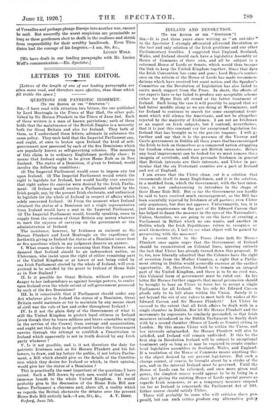CORRESPONDENCE.
THE JEWISH PERIL.
(To THE EDIPOB or THE " SPECTATOEP."]
Sue—The solemn wagging of heads in certain eminent newspaper offices over the anonymous pamphlet which calls itself The Jewish Peril would be intensely comical were it not a very disturbing symptom of the haunted and unwholesome condition in which the war has left the public mind. The pamphlet is a translation of a clumsy Russian forgery intended to pander to the superstition of the " Hidden Hand." There is, indeed, reason to believe that it has itself been engineered by a. more substantial hand reaching out stealthily from the arcanum of German Militarist Reaction.
The literary and political history of the pamphlet is quite easy to trace, though it has been a little obscured by its author's infirmities of memory. Fundamentally it belongs to a type of forgery which was common enough in. the 17th and 18th cen- turies when party passions ran high and the reckless scurrilities of political warfare could not be made effective without the concoction of bogus documents. In our own time this fraudu- lent traffic has become relatively rare, though the notorious Pigott and Dreyfus forgeries are there to show how easily it may be tempted into life when malicious controversialists venture on. accusations which they cannot otherwise substantiate. This is precisely the case of " Professor Sergyei Nilus," the alleged author of the Russian original of The Jewish. Peril.
His documented " discovery " that the Jews, in conspiracy with certain secret brotherhoods, are at the bottom of all the political and religious convulsions and all the social instabilities throughout the world has been devised to bolster up a theory which has long failed to convince. The theory itself is at least three centuries old. It was the staple of the pseudo-Apocalyptic literature of Antichrist and the Wandering Jew which assailed the early years of the Reformation and filled the literary armoury of the League during the Thirty Years' War. It took more definite political shape in the tracts and broadsheets, afterwards
collected by the German Clericals under the title of Anabap- tistieuna et Enthusiaetieuns Pantheon, which explained the Puritan Revolution in England—the Bolshevism of its day--as a plot against Christianity and Monarchy contrived by the Quicker, Frey-Geister tad Heil- and Gotaaten Judea. After the French Revolution and the upheavals of 1830 and 1848 a fresh impulse was given to the agitation. Meanwhile, the Illuminati had come into existence and Freemasonry had become known and they were promptly annexed by the scaremongers and substituted for the Quakers and Freethinkers in their new redaction of the " Hidden Hand." A number of blood-curdling works dealing in minute detail with their supposed activities as authors of the Revolutions were published by such writers as Father Barruel (1797, etc.), the Chevalier de Malet (1817), Eckert (1854), Gougenot des Mousseaux (1860), Cretineau-Joly (1863), Saint-Andre (1880) and Chabauty (1883). These books all fell flat. The blood of the public refused to be curdled, and to-day they are only found in secondhand bookshops or in the libraries of collectors of Masonic and Occult ana.
In 1868 an ingenious German named Hermann Goedsche, who had been dismissed the Prussian Postal service for forgery, conceived the idea of galvanising the agitation into effective life by fabricating a document which would prove all its theoretical extravagances. For the purposes of this delectable enterprise he pretended to be an Englishman named Sir John Ratcliffe. His document took the form of a Jewish avowal of all the designs and machinations attributed to the Jews by the writers men- tioned above. It introduced the public to a secret assembly of the " Elect of Israel " held once in every century round the tomb of a mythical " Grand Master Caleb, the Holy Rabbi Simeon ben Jehudah." The particular meeting of which Goedsche's document is a sort of Protocol is addressed by a Chief Rabbi who expounds the plan of Simeon, handed down from generation to generation, by which the Jews may secure their domination over all the nations. of the earth. This plan is in close agreement with the hypotheses of Gougenot des Mousseaux and similar writers. The Jews are to work with gold and the press for the subversion of Monarchy and Christi- anity. They are to act as a universal disturbing and demoralis- ing instrument and in particular they are to seduce and stir up the proletariat to political revolution, so that eventually they may establish the Jewish Universal Monarchy on the ruins of Christian society. This document, which passed unnoticed at the time, was seized upon in the early 'eighties by the more irresponsible elements of the anti-Semitic movement then in process of formation by Treitscbke and Stocker, and widely circulated as a broadsheet. It was reprinted in France as recently as 1911 by M. Kalixt de Woleki in a reehauffe of the notorious forgeries of Braafmann. It proved, however, a little too exigeant for the mentality of those relatively sober pre-war days, and it is significant that even M. Drumont, while appro- priating the theories of Gougenot des Mousseaux—without acknowledgment, by the way—takes no notice of Goedsche.
Now it needs but a very cursory glance at Goedsche's forgery and at its raw material in the treatises of the literary scare. mongers, notably Gougenot des Mousseaux, Saint-Andre and the Abbe Chaubauty, to perceive at once the fraud which has been practised on the public by Professor Nilus's book. But before we press this point home let us see whether Nilus himself has any reasonable explanation to offer of the provenance of his documents. It should be mentioned that these documents consist of a number of so-called " Protocols of the Learned Elders of Zion " in which, as in the Goedsche forgery, certain Jewish teachers are made to avow to their disciples the dark designs of Jewry for the corruption and subjugation of Chris- tendom. Nilus does not refuse to say how he came by these Protocols. On the contrary he gives us no fewer than three explanations. Unfortunately for him, they are not only elusive and incredibly melodramatic, but they are also hopelessly contradictory. Two of them will be found in the English edition. According to one the Protocols came from a deceased friend unnamed who received them from a woman also unnamed who stole them from " one of the most influential and most highly initiated leaders of Freemasonry . . . at the close of a secret meeting of the initiated in France." According to the other there was no woman intermediary and no despoiled French Freemason, but the whole business was done by the deceased friend himself who rifled the safes of " the Headquarter Offices of the Society of Zion to France." The inconsistency of these two stories may conceivably be explained, but it is not so easy
to account for the third story which Nilus relates in a third and enlarged edition of his work published in 1911. Here he tells us that the documents came not from France but from Switzer- land, that they were not Judeo-Masonic but Zionist, and that they were the secret Protocols of the Zionist Congress held in Basle in 1897. From these conflicting statements it is perfectly clear that Nilus is not a witness of truth and the damaging conclusion suggested by a comparison of his Protocols with the Goedsche forgery becomes irresistible.
The Protocols are, in short, an amplified imitation of Goedsche's handiwork adapted to the circumstances of the Russian Revolution of 1905. They are undoubtedly cleverer than Goedsche, and, indeed, far cleverer than Nilus himself, as judged by the crudeness and clumsiness of his comments upon them. The forgery was, perhaps, not his, but a forgery it unquestionably is. In its main lines it follows Goedsche very closely but borrows much additional matter from Gougenot des Mousseaux and also from modern Russian reactionary writers who have dealt with the evils of democracy. It would occupy too much space to quote all the parallel passages from the two forgeries, but it will perhaps suffice if I show how closely they follow one another in the central idea, common to both, that the Jews hope to accomplish their fell purpose by simulating sympathy with the proletariat and leading it into destructive and eventually suicidal political revolutions. Here are the main passages on this head :—
GOEDSCHE. NILUS.
" Our people are conserva- tive, faithful. to the religious ceremonies and customs which have been bequeathed to' us by our ancestors, but our interest exacts that we should simulate a zeal for the social questions which are the order of the day, especially those which deal with' the ameliora- tion of the condition of work- men. In reality our efforts should be directed to 'captur- ing this movement of public opinion. The blindness of the riasses, their propensity . to yield themselves to oratory as empty as it is sonorous makes of them an easy prey and a docile instrument of popularity and credit. We shall find without difficulty among our own people the expression of such factitious sentiments and as much eloqUence as sincere Christians find in their enthu- siasm. 'We must as much as possible sustain the prole- tariat and bring it within the reach of those who have money at their disposal. By this means we shall be able to raise the masses whenever we please, to lead them into upheavals and revolutions. Each of these catastrophes -sill advance by a long stride our own racial interests and will rapidly bring us nearer to our one great end—that of reigning over all the earth as it has been promised to us by our Father Abraham."
" We intend to appear as though we were the liberators of the labouring man come to free him from his oppres- sion, when we shall suggest to him to join the ranks of our armies of socialists, anarchists, and communists. . . . We gov- ern the masses by making use of feelings of jealousy and hatred kindled by oppression and need. . . . When the time comes for our Worldly Ruler to be crowned we will see to it that by the same means— that is to say, by making use of the mob—we will destroy everything that may prove to be an obstacle in our way.
. . . The populace in its ignorance blindly believes in printed words and in errons- ous delusions which have been duly inspired by us. . . The mob is used to listen to us who pay it for its attention and obedience. By these means we shall create such a blind force that it will never be capable of taking any deci- sion without the guidance of our agents placed by us for the purpose of leading them."
So much for the literary history of the Protocols. Their political history is scarcely less discreditable. They were not published because they were discovered—whether in the pages of Goedsche or elsewhere—but they were discovered because they were wanted for the ignoble purpose of a pogrom-weapon. In the first edition of his book, published in 1901, Mins knew nothing of them, but was absorbed by the more abstract aspects of the problem of Antichrist. In 1905 occurred the Russian Revolution, and this was followed by the incendiary conspiracy of the Okhrana to stir up pogroms all over Russia and drown the new Constitution in a welter of Jewish blood. Nilus appears to have been employed by the Okhrana in this wicked campaign. At any rate the Protocols first appeared at this date in the shape of small pamphlets or broadsheets, and they were only afterwards collected and incorporated in a second edition of Nilus's work as a denouement of his theory of the Judeo-Masonic nature of Antichrist. Nor has their rote as a pogrom-weapon been confined to the year 1905. Quite recently abstracts of them were widely circulated in Denikin's and Soltehak's armies, They were
printed in the Eparchial Library of Rostoll and ivere distributed by the remnants of the organiration of Black Hundreds known.
as the Union of the Russian People. How effective they were for their murderous purpose we know from the horrible massacres of inoffensive Jews and Jewesses, which dogged the footsteps of. Denikin's armies throughout South Russia.
But this was not the only sinister movement with which the Protocols seem to have been associated. The year in which they were first published in Russia was also the year of a very serious Russo-German intrigue against the formation of the Triple Entente ; and here again these Protocols-Lor rather their argument—appear as one of the main weapons of the plotters.
It will be remembered that in July, 1905, the basis of an anti- British Alliance was secretly agreed upon by the Tsar and the Kaiser at Bjoerkoe. A few months later, while the Treaty was still incomplete, Count Lamsdorf proposed to the Tsar that advantage should be taken of " the new friendly relations " with Germany to conclude an agreement between the two countries for combating the alleged Jewish and Masonic peril. Now, the secret Memorandum in which this precious scheme was set forth and which the Tsar formally approved in January, 1906, is virtually a reproduction of the anti-Semitic argument which the alleged " Protocols of the Elders of Zion " are designed to prove. It is true that the Protocols themselves are not men- tioned, but Count Lamsdorf is none the less positive, with the fabricators of those documents, that the Jews are the soul of the Revolutionary movement in Europe, that their " principal aim is the all-round triumph of anti-Christian and anti-Monarchist Jewry," that their millionaires subvention this movement with " gigantic pecuniary means," and that they are abetted in this enterprise by the Freemasons. The Protocols are, indeed, little more than a dramatic version of Count Lamsdorf s memorandum. It is difficult to resist the conclusion that in some occult way— perhaps not so very occult—Nilus's book was intended to serve the sinister ends of the pro-German foreign policy of Count Lamsdorf in the same way as it served the bloody purposes of the pogrom-mongers.
And now a few words about the English edition. Its history and aims are not quite as clear as those of the Russian original owing partly to the circumspect anonymity in which its sponsors have veiled themselves. It is inconceivable that it is intended to stir up pogroms in this country, though the suggestion is not obscurely made in recent articles in the Times and the Spectator. More probably—as has already been hinted—it is part of a German intrigue to prejudice the German general elections in favour of the Militarist Reactionaries and perhaps even to justify the forcible upsetting of the present German Government by means of another Kapp Putsch. Here is the evidence for this startling conjecture. The German Reactionaries have lately been putting all their money on anti-Semitism. Their publicity agencies in Charlottenburg and Munich have flooded the country with pamphlets denouncing the present Government as a Juda- ized Junta, the instrument of a far-reaching Judeo-Masonio conspiracy to ruin Germany and to involve the whole of Christian and Monarchical Europe in her fate. This campaign has lately become official, and a paragraph has been inserted in the Electoral Manifesto of the German Nationalists—the party of Kapp and Ltitzow—formally adopting anti-Semitism as a -plank in their platform. One of the aims of the party is to secure foreign sympathy and help, and they hope to do this by finding a common ground in anti-Semitism. In these circumstances the publica- tion of " The Jewish Peril " in England wears a disturbing significance, but it becomes much more disturbing when we find that simultaneously with it a German edition was published by the Charlottenburg Agency. under the title, Die Geheirnnisse der Weisen von Zion, with a dedication appealing not only to the German people but also to `.` The Princes of Europe." The object was clearly to get English support, and unfortunately the re• sponse was not long in coming. On May 8th the Times was inveigled into publishing an article expressing alarm at the revelations of the Protocols and calling for an investigation The delight of the German Reactionaries know no bounds. It was voiced by Count Reventlow in a long article in the Deutsche Tageszeitung of May 17th welcoming the Times's acceptance of the Jewish peril as an indication that English public opinion was beginning to recognize the righteousness of Kapp and Co. in their resistance to the Ebert regime and what the Count called the " pax Judaeica." Whether the translators and editors of " The Jewish Peril " have lionsciously lent themselves to this intrigue, which is part of the German Reactionary plot to upset the Treaty of Versailles and perhaps plunge Europe into another war, cannot be said. But assuredly the worst suspicions are permissible so long as these gentlemen elect to skulk in the coulisses and shrink from responsibility for their scrubby handiwork. Even Titus Oates had the courage of his forgeries.—I am, Sir, &c., Lucrx WOLF. [We have dealt in our leading paragraphs with Mr. Lucien Wolf's communication.—En. Spectator.]








































 Previous page
Previous page